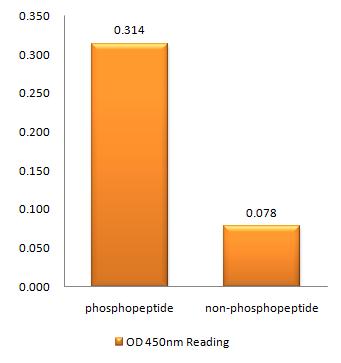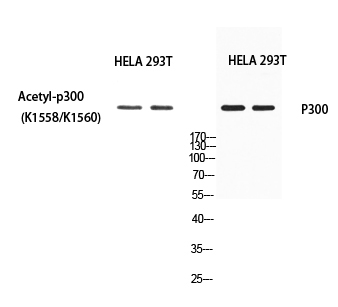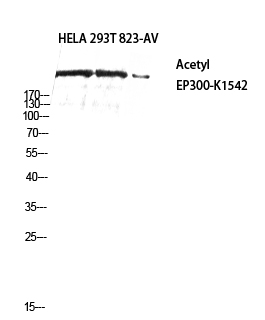
Catalog: KA3349C
Size
Price
Status
Qty.
96well
$330.00
In stock
0
Add to cart


Collected


Collect
Main Information
Reactivity
Human
Applications
ELISA
Conjugate/Modification
Unmodified
Detailed Information
Storage
2-8°C/6 months,Ship by ice bag
Modification
Unmodified
Detection Method
Colorimetric
Related Products
Antigen&Target Information
Gene Name:
EP300
show all
Other Name:
Histone acetyltransferase p300 ;
p300 HAT ;
E1A-associated protein p300 ;
p300 HAT ;
E1A-associated protein p300 ;
show all
Background:
catalytic activity:Acetyl-CoA + histone = CoA + acetylhistone.,disease:Chromosomal aberrations involving EP300 may be a cause of acute myeloid leukemias. Translocation t(8;22)(p11;q13) with MYST3.,disease:Defects in EP300 are a cause of Rubinstein-Taybi syndrome (RSTS) [MIM:180849]. RSTS is an autosomal dominant disorder characterized by craniofacial abnormalities, broad thumbs, broad big toes, mental retardation and a propensity for development of malignancies.,disease:Defects in EP300 may play a role in epithelial cancer.,function:Functions as histone acetyltransferase and regulates transcription via chromatin remodeling. Acetylates all four core histones in nucleosomes. Histone acetylation gives an epigenetic tag for transcriptional activation. Binds to and may be involved in the transforming capacity of the adenovirus E1A protein. Mediates cAMP-gene regulation by binding specifically to phosphorylated CREB protein. In case of HIV-1 infection, it is recruited by the viral protein Tat. Regulates Tat's transactivating activity and may help inducing chromatin remodeling of proviral genes.,online information:P300/CBP entry,PTM:Acetylated on Lys at up to 17 positions by intermolecular autocatalysis.,PTM:Citrullinated at Arg-2142 by PADI4, which impairs methylation by CARM1 and promotes interaction with NCOA2/GRIP1.,PTM:Methylated at Arg-580 and Arg-604 in the KIX domain by CARM1, which blocks association with CREB, inhibits CREB signaling and activates apoptotic response. Also methylated at Arg-2142 by CARM1, which impairs interaction with NCOA2/GRIP1.,PTM:Phosphorylated.,similarity:Contains 1 bromo domain.,similarity:Contains 1 KIX domain.,similarity:Contains 1 ZZ-type zinc finger.,similarity:Contains 2 TAZ-type zinc fingers.,subunit:Interacts with phosphorylated CREB1 (By similarity). Interacts with DTX1, EID1, ELF3, FEN1, LEF1, NCOA1, NCOA6, NR3C1, PCAF, PELP1, PRDM6, SPIB, SRY, TCF7L2, TP53, SRCAP, TTC5, JMY and TRERF1. The TAZ-type 1 domain interacts with HIF1A. Probably part of a complex with HIF1A and CREBBP. Part of a complex containing CARM1 and NCOA2/GRIP1. Interacts with ING4 and this interaction may be indirect. Interacts with ING5. Interacts with the C-terminal region of CITED4. Interacts with HTLV-1 Tax and p30II. Interacts with and acetylates HIV-1 Tat.,
show all
Function:
response to reactive oxygen species, regulation of cell growth, response to hypoxia, somitogenesis, liver development, regionalization, chromatin organization, transcription, regulation of transcription, DNA-dependent,regulation of transcription from RNA polymerase II promoter, protein amino acid acetylation, N-terminal protein amino acid acetylation, apoptosis, response to oxidative stress, cell cycle, pattern specification process, heart development,muscle organ development, skeletal muscle tissue development, cell death, regulation of cell size, response to endogenous stimulus, response to hormone stimulus, embryonic development ending in birth or egg hatching, positive regulation of biosynthetic process, anterior/posterior pattern formation, response to organic substance, response to inorganic substance, response to metal ion, positive regulation of macromolecule biosynthetic process, positive regulation of macromolecule metabolic process, positive regulation of gene expression, programmed cell death,striated muscle tissue development, death, chromatin modification, covalent chromatin modification, histone modification, histone acetylation, N-terminal peptidyl-lysine acetylation, peptidyl-lysine modification, peptidyl-lysine acetylation, regulation of proteolysis, positive regulation of cell growth, respiratory tube development, lung development, positive regulation of cellular biosynthetic process, N-terminal protein amino acid modification, response to corticosteroid stimulus, regulation of cellular protein metabolic process, positive regulation of cellular protein metabolic process, regulation of cellular component size, segmentation, tube development, regulation of growth,response to drug, response to hydrogen peroxide, homeostatic process, chordate embryonic development, positive regulation of DNA binding, protein amino acid acylation, positive regulation of molecular function, regulation of transcription, response to ethanol, positive regulation of cell size, positive regulation of proteolysis, positive regulation of transcription, DNA-dependent, positive regulation of growth, positive regulation of nucleobase, nucleoside, nucleotide and nucleic acid metabolic process, positive regulation of transcription, positive regulation of transcription from RNA polymerase II promoter, response to steroid hormone stimulus, regulation of transcription factor activity,positive regulation of transcription factor activity, regulation of binding, positive regulation of binding, regulation of DNA binding, positive regulation of nitrogen compound metabolic process, positive regulation of protein metabolic process, regulation of RNA metabolic process, positive regulation of RNA metabolic process, chromosome organization,response to glucocorticoid stimulus, response to calcium ion, muscle tissue development, skeletal muscle organ development, respiratory system development, response to oxygen levels,
show all
Cellular Localization:
Cytoplasm . Nucleus . Chromosome . Localizes to active chromatin: Colocalizes with histone H3 acetylated and/or crotonylated at 'Lys-18' (H3K18ac and H3K18cr, respectively) (PubMed:25818647). In the presence of ALX1 relocalizes from the cytoplasm to the nucleus. Colocalizes with ROCK2 in the nucleus (PubMed:12929931). .
show all
Signaling Pathway
Cellular Processes >> Cell growth and death >> Cell cycle
Cellular Processes >> Cellular community - eukaryotes >> Adherens junction
Organismal Systems >> Endocrine system >> Glucagon signaling pathway
Organismal Systems >> Endocrine system >> Growth hormone synthesis, secretion and action
Organismal Systems >> Endocrine system >> Thyroid hormone signaling pathway
Human Diseases >> Cancer: overview >> Pathways in cancer
Human Diseases >> Cancer: overview >> MicroRNAs in cancer
Human Diseases >> Cancer: specific types >> Renal cell carcinoma
Human Diseases >> Cancer: specific types >> Prostate cancer
Human Diseases >> Neurodegenerative disease >> Huntington disease
Environmental Information Processing >> Signal transduction >> Wnt signaling pathway
Environmental Information Processing >> Signal transduction >> Notch signaling pathway
Environmental Information Processing >> Signal transduction >> TGF-beta signaling pathway
Environmental Information Processing >> Signal transduction >> JAK-STAT signaling pathway
Environmental Information Processing >> Signal transduction >> HIF-1 signaling pathway
Environmental Information Processing >> Signal transduction >> FoxO signaling pathway
Environmental Information Processing >> Signal transduction >> cAMP signaling pathway
Reference Citation({{totalcount}})
Catalog: KA3349C
Size
Price
Status
Qty.
96well
$330.00
In stock
0
Add to cart


Collected


Collect
Recently Viewed Products
Clear allPRODUCTS
CUSTOMIZED
ABOUT US
Toggle night Mode
{{pinfoXq.title || ''}}
Catalog: {{pinfoXq.catalog || ''}}
Filter:
All
{{item.name}}
{{pinfo.title}}
-{{pinfo.catalog}}
Main Information
Target
{{pinfo.target}}
Reactivity
{{pinfo.react}}
Applications
{{pinfo.applicat}}
Conjugate/Modification
{{pinfo.coupling}}/{{pinfo.modific}}
MW (kDa)
{{pinfo.mwcalc}}
Host Species
{{pinfo.hostspec}}
Isotype
{{pinfo.isotype}}
Product {{index}}/{{pcount}}
Prev
Next
{{pvTitle}}
Scroll wheel zooms the picture
{{pvDescr}}



















